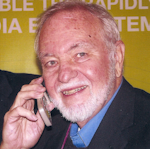Last year, Nokia developed the Wibree ultra-low-power personal-area networking (PAN) technology for very small and low-power applications, such as watches, toys, remote controls, sports, wellness, healthcare, and entertainment. Bluetooth, needing a spec to cover such ultra-low-power (ULP) technology, will incorporate Wibree for more widespread PAN connectivity.
Power consumption represents only a fraction (10% to 25%) of a standard Bluetooth chip. ULP Bluetooth operates in the same 2.4-GHz spectrum as Bluetooth and Wi-Fi. The modulation method is a version of frequency shift keying (FSK) with frequency-hopping spread-spectrum similar to but incompatible with Bluetooth. The data rate is 1 Mbit/s max, and the range is estimated to be 5 m or more under optimal conditions.
Because of a different protocol, a Wibree transceiver cannot communicate with a Bluetooth transceiver. Yet the two systems can co-exist without interference. Most applications are expected to use a dual-mode chip set that supports both Bluetooth and Wibree.
The Wibree Forum, which includes Broadcom, Casio, CSR, Epson, ItoM, Logitech, Nordic Semiconductor, STMicro, Suunto, Taiyo Yuden, and Texas Instruments, will become part of the Bluetooth SIG. The work they have done toward defining the specifications will continue. Bluetooth chip maker CSR is sampling a ULP Bluetooth chip set, while TI will offer ULP Bluetooth in the near future.
Bluetooth Special Interest Group
Wibree Forum
